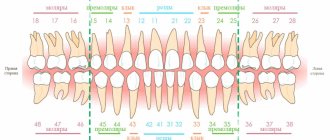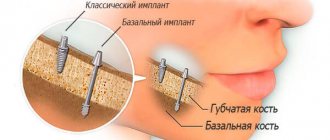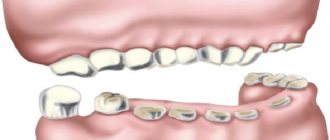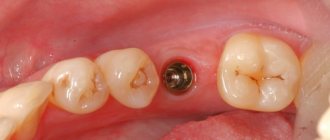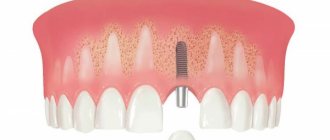The absence of even one tooth can cause both physical and psychological discomfort. That is why the simultaneous implantation procedure is very popular among patients. In a maximum of two visits, the patient solves his problem and gets a beautiful and healthy smile. As with any operation, dental implantation has its contraindications. Below we will look at all the features of the procedure and tell you for whom this method is suitable and who should resort to other procedures.
Single-stage implantation: what is it?
Instant prosthetics involves installing an implant immediately after removing a damaged tooth. This method is considered the most gentle and is recommended by doctors for those patients who do not have serious contraindications.
A thorough examination of the oral cavity should be done in advance, and if sanitation is indicated, the doctor will perform it before surgery.
The history of the express method of dental implantation
Back in the middle of the last century, Swedish professor Brenemark discovered the amazing property of titanium to organically fuse with bone tissue. This is how titanium implants appeared.
As a rule, implantation occurs in two stages: first, a titanium base of a new tooth is installed, which takes 4-6 months to grow into the bone tissue. And then a zirconium, composite or metal-ceramic prosthesis is attached.
During the period of ingrowth of the titanium implant, the hole remains empty or closed with a plastic insert. However, this type of implantation is not acceptable for all patients. This is how new, revolutionary protocols emerged that allow the installation of new teeth in one stage: All-on-4, All-on-6, basal implantation.
The main advantage of one-stage implantation is that after installing the titanium base, a temporary prosthesis is immediately placed on it, which is replaced with a permanent one after the implant has completely grown in.
This express method is often used for targeted restoration of damaged teeth in the smile area, because... In one visit, you can remove tooth fragments and immediately install a temporary crown.
Advantages of the method
The method has proven itself not only with a lower price and speed of treatment, but also with the following advantages.
- Installing a temporary crown allows you to preserve the natural contour of the soft tissues.
- High physiological and psychological comfort: all manipulations are performed in one visit.
- Possibility of preserving bone tissue.
- The method is highly physiological: the implant is installed exactly in the location where the tooth used to be, which ensures normal load distribution.
Indications for implantation
All medical procedures are carried out solely according to indications. Experts recommend that patients resort to simultaneous implantation for the following problems:
- restoration of the front row of teeth;
- trauma with soft tissue damage;
- severe tooth deformation;
- tooth extraction due to gum disease;
- urgent tooth restoration.
List of mandatory requirements for the procedure
During the initial examination, the doctor will assess the condition of the oral cavity for the possibility of carrying out immediate implantation. The procedure is performed only if the following requirements are met:
- Suitable volume of bone tissue.
- There is no inflammation in the area of the tooth root;
- Bone tissue without atrophic changes;
- The area of the extracted tooth without obvious tissue deformations;
- The gums are in satisfactory condition;
- The interradicular septum must be preserved.
Contraindications to one-stage dental surgery
Medical intervention should not be carried out if the patient has contraindications for this, which are divided into the following types:
- absolute (operation excluded);
- local (depending on the condition of the jaw);
- relative (the decision about the operation is made by the doctor).
The doctor eliminates all risks at the first examination and carefully examines the patient’s medical history. During the conversation, clarifying questions are asked to provide a complete picture of past and chronic diseases.
Let's consider absolute contraindications, in which simultaneous implantation is completely excluded:
- Allergy to the administration of anesthesia.
- Various blood diseases.
- All degrees of diabetes.
- Weak immunity.
- The bone tissue has undergone atrophic changes.
- Connective tissue does not recover quickly enough.
- Chewing muscles are in strong tone.
- Tuberculosis.
- The endocrine system has pathologies.
- Venereal diseases.
- Tumors of a malignant nature.
- Presence of mental illness.
- HIV infection.
Relative contraindications
These contraindications are only an obstacle to immediate implantation. The doctor decides how risky the procedure is.
- The gums are subject to inflammation.
- Some teeth require sanitation.
- The bite has pathological disorders.
- Presence of arthrosis changes.
- Tobacco use.
- Arthritis.
- Alcohol and drug addictions.
- Any trimester of pregnancy.
- The oral cavity is in unsatisfactory hygienic condition.
- Marginal periodontitis.
Local contraindications
- There is not enough bone tissue.
- The jaw arch is not dense enough and its structure is damaged.
- The short distance to the sinus makes the operation labor-intensive.
Temporary factors under which the procedure is possible
The doctor gives permission to perform the operation after the patient resolves the issue with the following factors:
- Chemotherapy.
- The period of rehabilitation after a somatic illness;
- Exacerbation of chronic and other diseases;
- Pregnancy.
After a course of chemotherapy, you should wait at least a year and only after this period can you have surgery. Let's not hide it - there is always a risk of implant rejection and the doctor will not give you a 100% guarantee, but the result is quite justified: the artificial tooth will look like a real one.
Despite the rather long list of contraindications, some of them can be corrected and treated. In addition, the procedure can also be performed by people of retirement age, which makes this procedure accessible and popular among patients of dental clinics around the world.
Advantages of one-stage dental implantation
Here we will look at the benefits of the procedure and talk about why patients choose it and doctors recommend it:
- the procedure takes place in a short time - a maximum of two days;
- the health of neighboring teeth is preserved;
- less manipulation than with classical implantation;
- gum formation begins immediately after the installation of the abutment and crown;
- pronounced aesthetic effect - the artificial tooth looks like a natural one.
It is obvious that one-stage implantation is significantly superior to traditional (classical) implantation, because it is not only more affordable, but also less traumatic. You don’t have to go to the clinic for a long time, just 2 days and your smile will be beautiful and natural.
Lifetime Warranty
We have created all the conditions to exclude medical and technological errors, so without fear we provide a lifetime guarantee for implantation
We work with the best premium implants from the leading company Nobel Biocare®, for which, together with the manufacturer, we provide an indefinite guarantee in the Dr.Levin LifeTime Warranty format . For each installed implant, a passport with a number and series is issued.
Since 2004 we have been the Nobel Biocare® Center of Clinical Excellence in Eastern Europe. This status is available provided that over 10 years of work, the percentage of rejection of implants installed in the clinic is less than 2%.
Preparation for implantation
Simultaneous dental implantation is a complex procedure that requires preliminary diagnosis of the condition of the oral cavity for dental caries and the presence of various inflammatory diseases. Implantation can be started only after complete treatment. To obtain reliable information about the height or level of the bone tissue into which the implant is planned to be implanted, it is necessary to take an X-ray of the teeth. If it turns out that there is not enough bone tissue to perform the operation, the doctor will first augment it.
Possible complications
Simultaneous removal and implantation of teeth has risks associated with implant rejection. Their occurrence is possible in the following cases:
- weak immunity of the patient;
- severe bruxism;
- smoking tobacco;
- systemic diseases during exacerbation.
The individual approach to treatment practiced by the Saint-Dent Clinic allows us to prevent and minimize possible complications.
Stages of one-stage implantation
Fear of the dentist is a fairly common problem, despite the fact that modern methods and materials can significantly reduce pain during treatment. The worries will not be so strong if you initially know all the stages of the procedure and see that there is nothing to fear:
- Before the operation, a consultation is always carried out with a detailed diagnosis of the patient’s condition.
- A CT scan of the jaw is performed.
- A decision is made on the advisability of the operation.
- The doctor makes a 3D simulation of the operation.
- The patient is given local anesthesia.
- Complete removal of the deformed tooth is performed;
- Using a special drill, a hole is drilled in the bone tissue of the jaw.
- The hole is expanded to the optimal diameter with a special tool.
- The implant is implanted through the root socket: the element is screwed into the jaw.
- Next, the abutment is fixed to the implant.
- A temporary composite crown is installed.
A temporary crown should be worn until the implant is completely healed. On average no more than six months. Then a permanent crown is installed from durable, abrasion-resistant materials: metal ceramics or zirconium dioxide.
Recovery postoperative period
After the operation, the recovery period begins, the person has solved his problem and now there is an implant instead of a damaged tooth. How to care for it and what should you be wary of on the doctor’s recommendation until the tooth finally begins to feel like your own?
For the first few days, the patient will experience slight swelling, which will cause discomfort. This is normal because surgery was performed. It is worth avoiding excessive chewing loads during this period and carefully monitoring oral hygiene using special antiseptics. During the first month, the discomfort goes away, and the patient forgets that he has an implant installed.
Review statistics among specialists and patients
The one-stage prosthetics method began to be used in Russia relatively recently, while in Europe such services have been provided for several years. Analyzing world statistics, you can see that this method has collected a large number of positive reviews and enjoys well-deserved trust among both doctors and patients. The problem of a missing tooth is solved in record time.
Single-stage implantation also perfectly solves the aesthetic component of the problem: there are patients who do not like the look of their own teeth. They delay visiting the dentist and go without a tooth for a long time, not deciding on implantation. In addition, many people think that implantation takes a long time and are unable to find a place for the procedure due to their busy work schedule. However, the procedure is performed quickly and the installed tooth will look aesthetically pleasing and natural. Negative reviews can only be found regarding dissatisfaction with the price: the procedure is not budget-friendly and not everyone can afford it.
Branded rehabilitation - for quick recovery
A unique complex of accelerated rehabilitation
- Lymphatic drainage. Biostimulants improve lymph outflow, prevent the formation of edema and hematomas, tighten the facial contour
- PRP plasma lifting. Platelet-rich blood plasma heals, stops the appearance of hematomas, and reduces swelling
- Microcurrent therapy. Low frequency currents relieve facial microspasms and pain, improve metabolism and healing
We work exclusively with premium implants from the leading company Nobel Biocare®. The line of implantation systems allows you to select the necessary implant in any clinical situation, including simultaneous implantation after the removal of anterior or chewing teeth. We provide a lifetime warranty for implantation together with the manufacturer.
Price
The technique of one-stage implantation requires the use of high-quality materials and modern equipment. In addition, the highly qualified implantologist is very important. The total cost of the procedure consists of consumables, the level of the doctor and the clinic. If the clinic has its own dental laboratory, the cost of the implant will be significantly lower. The average price for a turnkey installation is 45 thousand rubles. The service life of implants reaches 25 years, provided that high-quality materials are selected and the procedure protocol is strictly followed. The best implants are those made in Sweden, Israel and the USA.
Differences from the classical method
Simultaneous implantation allows you to combine two operations: removal and installation of the implant. This reduces treatment time, makes it possible to immediately receive a temporary prosthesis and restore the integrity of the dentition.
Thanks to a simpler algorithm, such treatment is cheaper; you can find prices for services at the Saint-Dent Clinic in the price list.
It is important to know! The cost of treatment is calculated individually, based on the characteristics of each patient’s situation.
